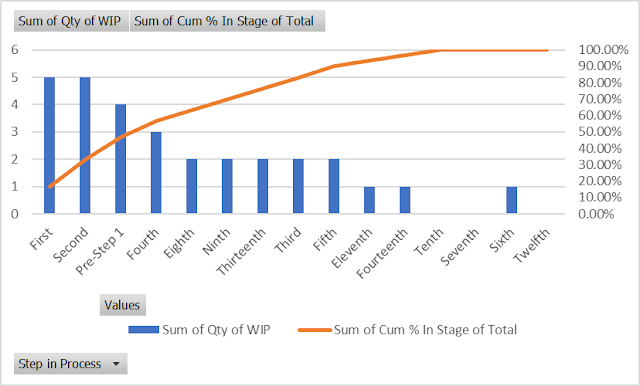According to the Wikipedia, “A Pareto chart, named after Vilfredo Pareto, is a type
of chart that contains both bars and a line
graph, where individual values are represented in
descending order by bars, and the cumulative total is represented by the line.”
A related Wikipedia article on the 80/20 Rule states
that “It is a common rule
of thumb in business; e.g., "80% of your sales come from 20%
of your clients."
AJC maintains that “Pareto” should be
part of your lexicon. And, despite that
dictionary.com only has “Pareto” in as a noun or modifier, I often use the word
“pareto” as a verb, as in “pareto that out”- meaning chart the data by category
and plot it in order. It is a terrific
way to see where the “biggest fish” in your business are, as in what are the
greatest few items to prioritize.
This
way of considering items is helpful in so many ways as it can be used to
indicate the greatest profit drivers, greatest volume of sales with which
subset of SKUs, greatest defects, greatest WIP in a process, etc.
To illustrate,
consider the following examples:
Company
wanted to start an online distribution channel, but was unsure which of their 655
SKUs to put on it to start. Turns out
only 12% of their 655 SKUs (about 80 products) were making up 80% of their
sales volume.
Blown
up to show just the top 80% of SKUs: 80 of the 655 SKUs. Recommendation: Put those
80 products online first!
This
company wanted to know in which category to focus their initial sales efforts
when expanding to a new geography.
Looking at their historical sales, it appears that only 2 of their 6 categories
drives 80% of their volume.
Here
is a final example to show where Work-In-Progress (WIP) is located in a
multi-step process. The company needed
to know where WIP was building up in order to assign more resources to the
steps most in need. Although the 80/20
rule is not perfectly followed here, it is obvious that about 4 of the fifteen
steps in the process have the majority of the volume of WIP; a good place to
begin assignment of additional efforts.
As
can be seen, once data is “pareto-ed out,” it becomes visually obvious where
the greatest opportunities lie. It is a
great idea to make Pareto part of your company’s every day lexicon, and get to
charting!
Read
this article and more on AJC’s blog, and sign up for our newsletter online at: http://andreajonesconsulting.com/blog.aspx





No comments:
Post a Comment